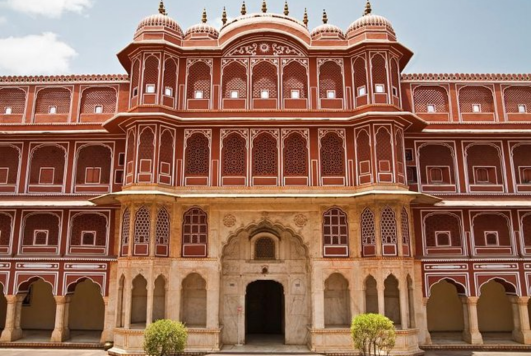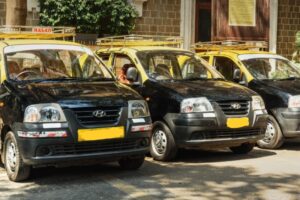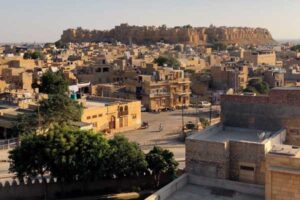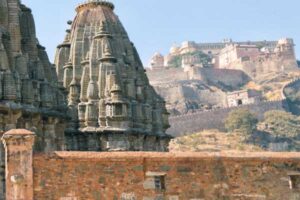City Palace Jaipur
City Palace Jaipur
Overview Of City Palace Jaipur
you will feel like you’ve stepped into the Rajput era the moment you arrive in Jaipur. Throughout the year, the city sees a consistent influx of visitors due in large part to its abundance of architectural wonders. The City Palace, located in the heart of Jaipur, is an excellent example of such magnificent architecture. The City Palace is a relic from the time when noble families reigned over the metropolis.
The City Palace Jaipur is held in high regard due to its majestic design and historical significance. The moment you enter the palace, all you can do is gape at the stunning design and priceless items on display. Until you’ve processed everything, you won’t be able to move. The City Palace in Jaipur was formerly the private palace of the Jaipur royal family; now, however, it is divided into two different portions, the first of which is home to a variety of museums and courtyards.
Old Jaipur, where the City Palace Jaipur is located, takes up around 7 percent of the city’s overall size. The palace was started in 1732. It looks perfect even after all these years. The palace is separated among courtyards, gardens, and palaces.The museum was put up in part of the City Palace Jaipur. It let guests to see all the royal family’s antiques and other items. This magnificent palace showcases Jaipur’s rich past. The Rajputana, Mughal, and European styles are well integrated within the building’s architecture. Royal dynasties formerly called this area home, and this massive estate is a testament to their glory and heritage.
COST EFFICIENT SERVICES
Provide highly efficient services at very competitive prices.
ATTRACTIVE PACKAGES
Exclusively customized packages for Rajasthan & India tours.
CAR RENTAL SERVICES
Hire a taxicab in Jaipur for local sightseeing and outstation needs.
100% SATISFACTION
Our company provides 100% customer satisfaction as it is our top priority.
24+ Year
Experience
20+ Tour
Destinations
15000 + Happy
Customers
History Of City Palace Jaipur
Sawai Jai Singh, the founder of Jaipur and the head of the Kachwaha Rajput Clan, ordered the building of City Palace. In the 17th century, Prince started construction on the City Palace Jaipur with the intention of making Jaipur the new capital of Rajasthan rather than Amber. The City Palace Jaipurwas his home and place of rule. His goal was to replace Amber with Jaipur as the state capital. King Raja Man Singh II of this royal line was the last monarch to rule from this City Palace Jaipur. The beautiful structure was designed by architects Vidyadhar Bhattacharya and Samuel Swinton Jacob, who drew inspiration from European styles.
What To See In City Palace Jaipur
The City Palace Jaipur exemplifies the beautiful synthesis of Rajputi, Mughal, and European architectural traditions. During its creation, the architects and builders kept in mind the principles of ‘Vastu Shastra.’ This probably enhance both the quality of life inside a house and the manner people chose to live there.
The City Palace Jaipur had the design of the “Grid Style,” earning it four gates named “Udai Pol,” “Tripolia Gate,” “Jaleb Chowk,” “Virendra Pol.” The various palaces, gardens, courtyards, temples, terraces, balconies, and patios make up this building. They are decorated with latticework, carved marbles, jali work, and inlaid ornamentations. Various paintings, mirrors, and latticework typify the classic Mughal style of wall decoration.
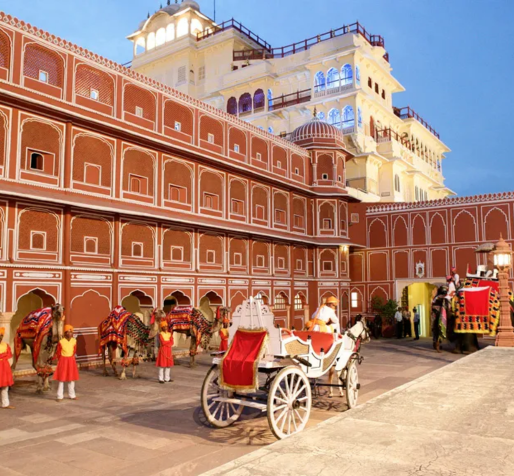
The Gates Of City Palace Jaipur/ Pitam Niwas Chowk
The City Palace Jaipur may be accessed by one of three gates: the Tripolia Gate, Virendra Pol, or Udai Pol. There are also four smaller gates in the courtyard of the main palace that provide access to the Chandra Mahal. The locals call this intersection Pritam Niwas Chowk. These gates are said to have been constructed to represent not just the four seasons, but also the four most central deities in Hinduism: Vishnu, Shiva, Parvati, and Ganesha.
The Mor gate represents the changing of the seasons and takes its name from the Old English term for peacock, from whence the word “Mor” is derived. Exquisite three-dimensional images of peacocks adorn the gate, which, by good accident, also provide a lovely setting for pictures. In contrast to the Leheriya Gate, which is more closely connected with spring, the Lotus Gate is associated with summer. Only in Rajasthan can you find the distinctive Leheriya print. Women in Rajasthan often dress in it throughout the spring season.The last one is called the rose gate because it is decorated with rose carvings that are symbolic of the winter season. All of these gates are works of art, and tourists often stop to snap pictures of them.
Mubarak Mahal
The “Welcome Palace,” or Mubarak Mahal, dates back to the 19th century when it was built by Maharaja Madho Singh II to welcome and entertain guests. Since the Maharaja often hosted foreign dignitaries here, the building’s design incorporates characteristics typical of European architecture.
The City Palace Jaipur is now home to the Maharaja Sawai Mansingh Museum, which has a spectacular collection of Pashmina shawls, robes, and outfits with Sanganeri block print, among other clothes formerly used by the royal family.
It’s worth noting that Maharaja Sawai Madho Singh I was quite a heavyweight despite his little stature. His clothing is among the relics here. Members of the royal family may be seen modelling some of the outfits on display in black and white photographs that line the walls of the show. On the festival of Diwali, the ladies of the royal family are seen wearing traditional black garments embellished with gota patti embroidery. This dress is an illustration of this kind of clothing.
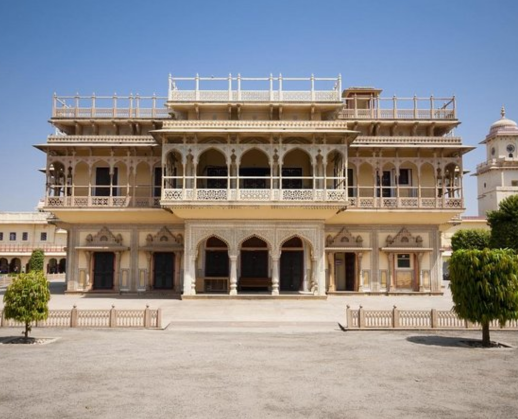
Chandra Mahal
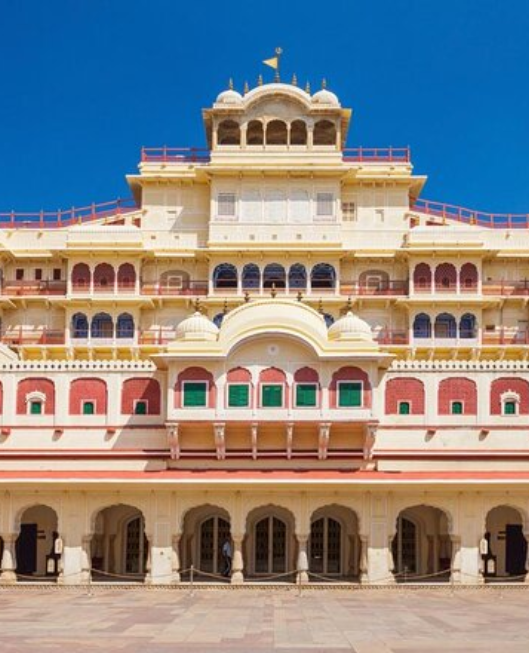
The Chandra Mahal, located on the western side of the City Palace, has a beautiful peacock gate at its entry. The intricate floral carvings, paintings depicting scenes from Jaipur’s ancient past, and glittering mirror embellishments will leave you in awe. Each of the seven floors of this building has been given its own unique name, such as the Ranga-Mandir, Sukh-Niwas, Mukut Mahal, Pitam-Niwas, Shri-Niwas, or Chhavi-Niwas.
The term “Sukh Niwas” translates to “white with a touch of blue,” and simply being there will calm your mind. The floor of this temple is covered in mirrors; it is called the “Rang Mandir,” and the walls, pillars, and ceiling are all reflected as well. The ceiling and pillars of the dining hall on this floor have intricate Mughal patterns, and the tables are fit for a king. The walls of ‘Shobha Niwas,’ which are tiled in blue and decorated with gold leaf, are covered with mirrors.
As beautiful as the rest of the palace is, the ‘Chhavi Niwas’ was the Maharajas of Jaipur’s monsoon retreat. The city flag of Jaipur is hoisted daily atop the Mukut Mandir pavillion, which is located on the very top of the Chandra Mahal.
You’ll need to buy a separate ticket to see Chandra Mahal, since much of it serves as a palace for the royal family. The museum may be found in the basement. The royal family’s own manuscripts, rugs, and other artefacts provide a glimpse into the past and give tourists a taste of the city’s rich history.
The Armory
Anand Mahal Sileh Khana, or the Maharani Palace, was the previous name for this armoury. while you first walk inside this armoury, your eyes are drawn to the life-size replica of a horse outfitted with full-body armour, much as horses of old would have worn while accompanying their riders into war.
When it came to weapons, the Rajputs had a veritable arsenal at their disposal. Knives, daggers, knuckle braces, and weapons are just some of the amazing items that may be seen at this armoury. Some weapons, like daggers, have such intricate and gorgeous carvings and inlay work on their handles that it’s almost easy to forget the horrors they saw in action. Several of these exquisite weapons, dating back to the 15th century, are on exhibit.
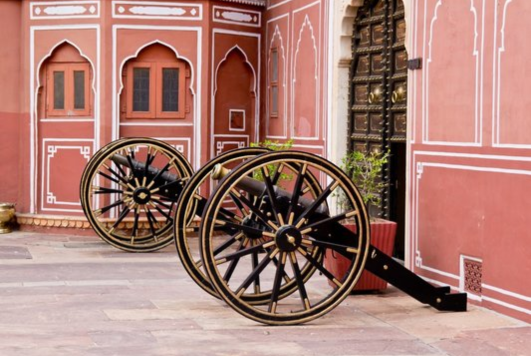
Bagghi Khana
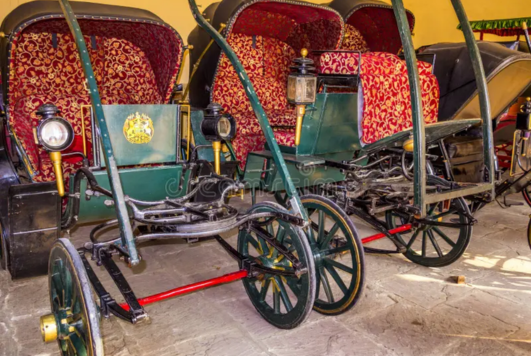
The name “bagghi” is derived from the Arabic word for “chariot,” and this site features several different types of chariots and other vehicles used by the royal family. You may also see the European-styled cab that was a gift from Queen Victoria to Maharaja Sawai Ram Singh II in 1876 and the royal chariot that was used to transport the royal deity.
Diwan-e-Khaas
When the Maharaja wanted to meet in private with his courtiers to address pressing concerns, he would do so in this regal darbar. No photos may be taken in this section of the City Palace Jaipur. The “Takht-e-Rawal,” or royal throne, and the chairs used by the courtiers adorn this chamber. This room’s ceiling is a warm and inviting combination of gold and crimson.
The walls of this chamber are covered with priceless artefacts, including handwritten Hindu texts, embroidered carpets, and life-size paintings of Jaipur’s Maharajas.
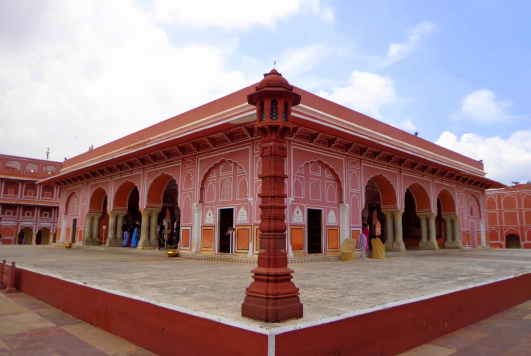
Diwan-e-Aam (Sarvato Bhadra)
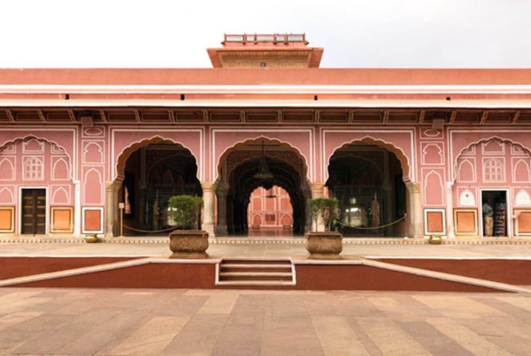
Upon entering City Palace Jaipur, you will first come to the Diwan-e-Aam, an open hall. It originally served as the venue for public audiences held by the Maharajas of Jaipur for the city’s populace. The hall’s ceiling is very ornate, and it has stunning crystal chandeliers.
There are also two huge silver urns, or Gangajalis, displayed in glass cases in this area. These containers are so massive that their 4,000-liter capacity earned them a place in the Guinness Book of World Records. According to folklore, the Maharaja Sawai Madho Singh II used these boats to bring holy Ganges water with him on diplomatic visits to England.
The floor of this room is beautiful marble, and there is a giant chariot wheel shown behind glass on one of the walls. These two aspects are not to be overlooked. Several shops selling authentic Rajasthani attire and other regional specialities may be found in this hall.
Govind Dev Ji Temple

A large number of visitors pay their respects at this temple, which is devoted to Krishna, every day. The temple is packed with devotees during the Shri Krishna Janmashtami festival.
Architecture of City Palace Jaipur
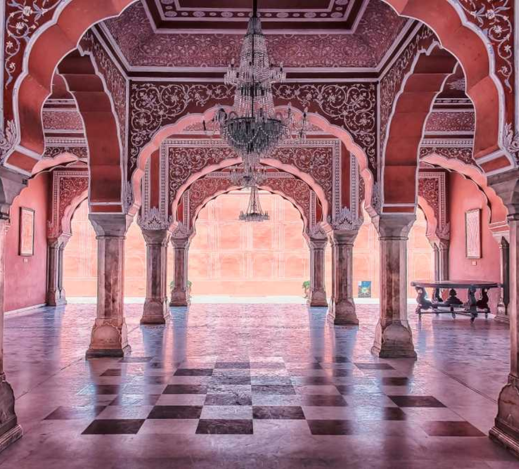
Beginning with the palace’s outside wall, Maharaja Jai Singh II built the initial structure of the City Palace Jaipur. In the decades afterwards, new buildings and courtyards have been built to the grounds, such that every structure inside the palace can be pinpointed to a certain era.
City Palace Jaipur is a beautiful example of a synthesis of Mughal, Rajput, and European architectural traditions. This pink and red sandstone castle was built with large courtyards and several smaller palaces with arched entrances. These smaller palaces have recently been converted into museums, and guests may choose between self-guided tours and guided tours.
Throughout the City Palace Jaipur grounds, you’ll come across historical relics like cannons and monumental sculptures that will captivate you and prompt you to stop so that you may snap pictures of them from a variety of angles. Especially so as you go from courtyard to courtyard. As soon as you enter the palace’s front doors, you should pause to take in the building’s ornate details.
How to reach
It is 13.1 km from the City Palace Jaipur to the Jaipur International Airport. That is advisable that you book a cab in advance. It is possible either over the phone or online, for a trip of this length. You may save money by using the bus, which operates in your area. Get out at Tripolia Bazar or the next-best stop, Badi Chopar, and walk the remaining distance to the City Palace.
Entry Fees for City Palace
The palace serves as the official dwelling of the royal family as well as a museum, hence separate entry tickets are needed for each. Another option is to purchase a combo ticket, which allows you to enter both museums for the price of only one.
TIn India, admission to the museum and gardens is INR 200 for adults and INR 100 for children aged 5 to 12.
A nightly visit costs INR 500 for Indian citizens, INR 250 for children between the ages of 5 and 12, and INR 1000 for foreign citizens.
For a combined ticket, Indian adults pay INR 300 and Indian children aged 5 to 12 pay INR 200; foreign adults pay INR 700 and foreign children aged 5 to 12 pay INR 400.
Children (ages 5 to 12) pay INR 1000 while adults (over the age of 18) pay INR 1500 for the Royal Grandeur (Chandra Mahal tour). In other countries, the same vacation costs adults INR 2,000 and children between the ages of 5 and 12 INR 1,500.
A Royal Splendour (special ticket) costs INR 3000 for an adult in India, INR 1500 for a kid aged 5 to 12, INR 3500 for an adult from another country, and INR 2000 for a child from another country.
Best Time To Visit
As far as they’re concerned, there’s never a suitable moment to go to a temple since worshippers may go whenever they like. While the Moti Doongri temple has a large number of people every day, Wednesday is always one of the busiest days there. Lord Ganesha is revered as Mercury’s patron god, and Wednesday is considered to be Mercury’s day. The end of October and the beginning of March are the most ideal times to visit the City Palace. Wait till it is a more acceptable temperature before seeing the city of Jaipur since the winters there are not as hot as the rest of the year.
